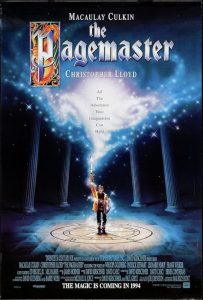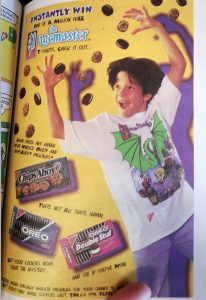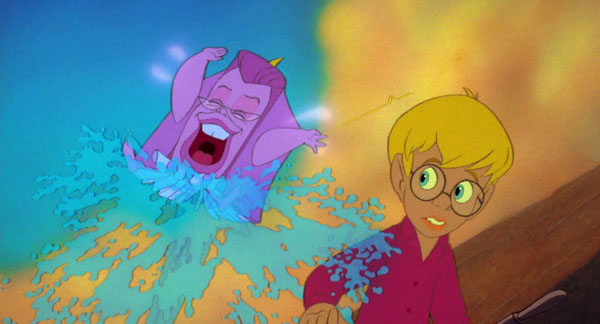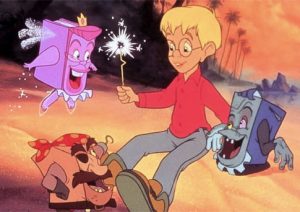


 “Twentieth Century Fox invites you on the adventure of a lifetime in the most magical film of 1994!” This was how the narration for the teaser trailer for The Pagemaster started, a perfect example of the hyperbolic marketing in the 90s that aimed to turn every movie into an “event.”
“Twentieth Century Fox invites you on the adventure of a lifetime in the most magical film of 1994!” This was how the narration for the teaser trailer for The Pagemaster started, a perfect example of the hyperbolic marketing in the 90s that aimed to turn every movie into an “event.”
While The Pagemaster may not have ignited the box office the way other animated features of the decade did, the film did strike a chord with a generation who not only recall bringing their parents in tow to theaters during the holiday season of 1994 but also playing the movie on non-stop VHS repeat afterward.
This fall marks the 30th anniversary of this film, an animated feature with a live action opening and conclusion. The Pagemaster dared to do something different for animation, as noted by Los Angeles Times film critic Peter Rainer when the film debuted. He wrote: “The Pagemaster is a feature-length mostly animated commercial for the pleasures of library-going. It’s rare that a kiddie film makes such a show of plumping for the opposition. If the movie succeeds, it could backfire for the producers. Kids might stay at home reading Treasure Island or Jack and the Beanstalk instead of trooping out to see and re-see The Pagemaster.”

A tie-in with Nabisco didn’t help.
As the film opens in live action, we meet Richard Tyler (played by Macaulay Culkin), a nervous young boy who fears almost everything. When Richard rides his bike to the store on an errand for his father, he is caught in a thunderstorm and takes refuge in a nearby library.
While there, Richard meets Mr. Dewey (Christopher Lloyd), the librarian who bequeaths Richard with a library card. Shortly after, Richard slips, hits his head, and imagines artwork on the library ceiling coming to life, engulfing Richard in a wave of paint. When it’s gone, the film transitions to animation and Richard, says, “I’m a cartoon!” after which the mystical, wizard-like Pagemaster (the voice of Lloyd) appears to correct him, “You are an illustration!”
He points Richard to an exit, and as Richard makes his way through the library, he is befriended by three anthropomorphic books – Adventure (Patrick Stewart), Fantasy (Whoopi Goldberg), and Horror (Frank Welker). They agree to assist Richard if he will use his new library card to check them out.
From here, Richard and his “bookish” friends go on a journey through some of literature’s greatest stories – Moby Dick, Treasure Island, Jack and the Beanstalk, and Dr. Jekyll and Mister Hyde.

The live-action bookends of The Pagemaster were directed by Joe Johnston, a former special effects artist with Industrial Light and Magic, who would also direct such films as Honey, I Shrunk the Kids (1989), The Rocketeer (1991), Jumanji (1995) and Captain America: The First Avenger (2011).
The rest of the film in its animated form was directed by Maurice Hunt, an animation veteran who had been working in the industry since the 1980s at such studios as Hanna-Barbera and Disney, where he would go on to helm the surrealistic “Symphony Number 5” section of Fantasia 2000.
 Hunt and his team (which included animators who had worked on An American Tail and Aladdin) bring a flair to the animation, which includes creative character design touches – the books have the looks of genres that they represent – Adventure is a pirate, Fantasy is a combination of Mother Goose with fairy wings, and Horror is a monster, albeit a lovable one.
Hunt and his team (which included animators who had worked on An American Tail and Aladdin) bring a flair to the animation, which includes creative character design touches – the books have the looks of genres that they represent – Adventure is a pirate, Fantasy is a combination of Mother Goose with fairy wings, and Horror is a monster, albeit a lovable one.
The animation, a co-production of Turner Feature Animation and Hanna-Barbera, features several sequences in the film that play out well, including action scenes involving an encounter with Ahab’s famed white whale and a concluding battle with a fire-breathing dragon. Additionally, Dr. Jekyll’s turning into Mr. Hyde (both voiced by Leonard Nimoy) is effectively staged, with much of the transformation happening off-screen or in the shadows.
The Pagemaster was released with a lot of fanfare. It came to theaters on November 23, 1994, the day before Thanksgiving, and associated promotion included everything from a “making of” TV special on Fox to toys available at Pizza Hut (good ol’ fast food premiums were a staple of animated features in the 80s and 90s).
 Although it didn’t initially fare well, many have caught up with The Pagemaster in the three decades since its release. In a recent article on Screen Rant, writer Hannah Gearan wrote about favorable thoughts that a group of visual effects artists, dubbed “The Corridor Crew” shared after looking back at the film. The article states:
Although it didn’t initially fare well, many have caught up with The Pagemaster in the three decades since its release. In a recent article on Screen Rant, writer Hannah Gearan wrote about favorable thoughts that a group of visual effects artists, dubbed “The Corridor Crew” shared after looking back at the film. The article states:
“Though there is an undeniably dated feel to The Pagemaster, it is vital to understand the era in which it was made. 1994 fell before the rise of 3D computer animation, which arguably began with Pixar’s meteoric success the next year with Toy Story, which further rose as the Disney subgroup created more films. Thus, The Pagemaster was far more limited with its technological access than what a studio could do now. When faced with a lack of technology, The Pagemaster team leaned in to figure out any workaround that they could.”
Thirty years later, many feel that The Pagemaster stands as this admirable product of its time.
That is reflected in a quote featured in the “making of” documentary, from Barry Weiss, co-producer of The Pagemaster. His words about 2D animation are now nostalgic: “What makes it special is that it’s probably one of the last hand-crafted things done in the world today. We use computers for some of the imagery and some of the painting and such. For the most part, it starts with an artist in a room with a blank piece of paper and a pencil.”